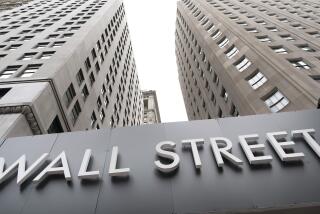Merger Activity Picks Up Steam
- Share via
Merger mania has gained momentum.
Capped by three mega-deals in recent days, the dollar volume of mergers and acquisitions in January jumped 44% from a year earlier to $120.1 billion, according to FactSet Mergerstat, a Santa Monica-based research firm.
On Monday, MetLife Inc. agreed to buy Citigroup Inc.’s Travelers Life & Annuity unit for $11.5 billion and, as expected, SBC Communications Inc. said it would purchase AT&T; Corp. for $16 billion.
Those deals came on the heels of Friday’s bombshell announcement by Procter & Gamble Co. that it would make the biggest acquisition in its 168 years: Gillette Co. for $57 billion.
The takeover spree, which began last year, is seen as a sign of confidence in the economy by corporate leaders looking for ways to expand their fiefdoms. Indeed, the deals unveiled Monday helped spark a stock market rally that lifted the Dow Jones industrial average 62.74 points.
The rebound began a year ago, when J.P. Morgan Chase & Co. announced its $58-billion purchase of Bank One Corp. The trend gained steam with a slew of deals in December, including Kmart parent Kmart Holding Corp. revealing plans to swallow Sears, Roebuck & Co.
“December was the big bang to end 2004, and it hasn’t let up,” Mergerstat analyst Jason Ghassemi said. “The investment bankers we talk to expect 2005 to be even bigger than last year. It may not be 1999 and 2000 again, but this is a robust market.”
December and January marked the first back-to-back months of more than $100 billion in acquisitions involving U.S. companies since the fall of 2000, Mergerstat said.
The volume for December was $128.4 billion, the most since October 2000.
Analysts said this could be the first year of more than $1 trillion in deals since 2000, when the stock market downturn and a softening economy made companies leery about gambling on acquisitions.
Annual volume topped $1 trillion from 1998 through 2000, peaking at $1.5 trillion in 1999, Mergerstat said. Volume bottomed out at $445.3 billion in 2002 before rising to $770.5 billion last year.
Although mega-deals grab the most attention, companies of all sizes have gotten in on the action, said Jim Freedman, managing director at Barrington Associates, an L.A. investment bank.
“The large deals tend to fuel the psychology that helps other deals get done,” Freedman said. “There is a trickle-down effect.”
Freedman said that Barrington, which specializes in the so-called middle market of deals ranging from $25 million to $500 million, was the busiest it had been in years, shopping more than 30 companies.
Potential sellers are scrambling to take advantage of valuations relative to corporate earnings that had risen at least 20% in the last three months, Freedman said. “The supply of companies for sale increases dramatically whenever that happens. They tend to crawl out from under the rocks.”
The average purchase price in January was $613 million, versus $259 million a year ago, Mergerstat noted.
Global competition is another factor, because companies are forced to consider mergers aimed at making them more cost-effective.
“Everything has become about efficiency,” Freedman said. “Very few people can win the war with price increases anymore.”
Jittery executives had been reluctant to make bold acquisitions after the stock market downturn and the Sept. 11, 2001, terrorist attacks, but a resilient U.S. economy has them eager to gamble again, said Brooks Dexter, senior managing director at USBX Advisory Services in Los Angeles.
Gross domestic product grew at roughly a 4% rate in 2004. It is expected to do so again this year.
“That gives CEOs the confidence to execute on strategic deals, be they big or small,” Dexter said.
More to Read
Inside the business of entertainment
The Wide Shot brings you news, analysis and insights on everything from streaming wars to production — and what it all means for the future.
You may occasionally receive promotional content from the Los Angeles Times.










